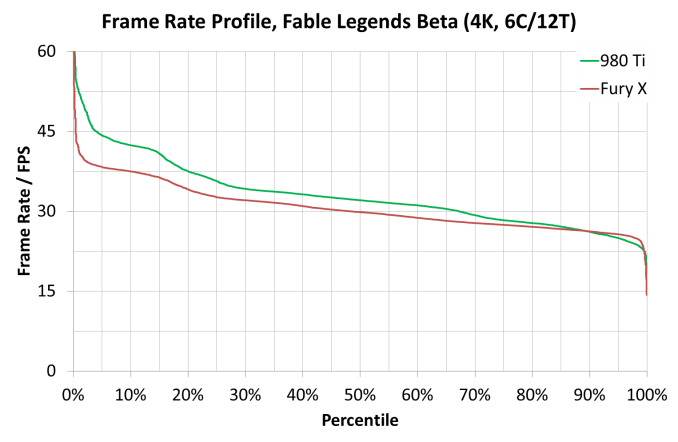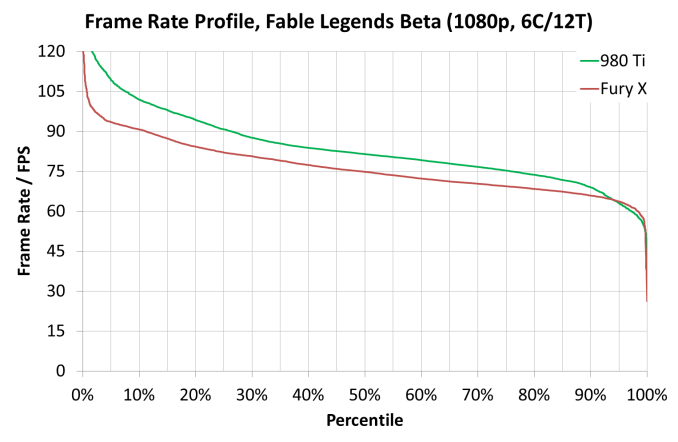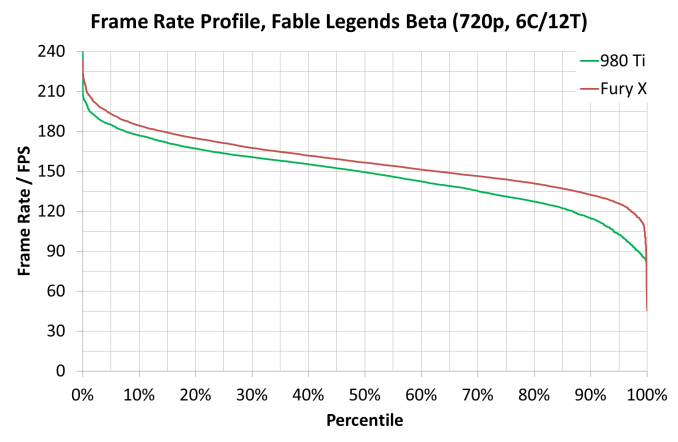Fable Legends Early Preview: DirectX 12 Benchmark Analysis
by Ryan Smith, Ian Cutress & Daniel Williams on September 24, 2015 9:00 AM ESTComparing Percentile Numbers Between the GTX 980 Ti and Fury X
As the two top end cards from both graphics silicon manufacturers were released this year, there was all a big buzz about which is best for what. Ryan’s extensive review of the Fury X put the two cards head to head on a variety of contests. For DirectX 12, the situation is a little less clear cut for a number of reasons – games are yet to mature, drivers are also still in the development stage, and both sides competing here are having to rethink their strategies when it comes to game engine integration and the benefits that might provide. Up until this point DX12 contests have either been synthetic or having some controversial issues. So for Fable Legends, we did some extra percentile based analysis for NVIDIA vs. AMD at the top end.
For this set of benchmarks we ran our 1080p Ultra test with any adaptive frame rate technology enabled and recorded the result:
For these tests, usual rules apply – GTX 980 and Fury X, in our Core i7/i5/i3 configurations at all three resolution/setting combinations (3840x2160 Ultra, 1920x1080 Ultra and 1280x720 Low). Data is given in the form of frame rate profile graphs, similar to those on the last page.
As always, Fable Legends is still in early access preview mode and these results may not be indicative of the final version, but at this point they still provide an interesting comparison.
At 3840x2160, both frame rate profiles from each card looks the same no matter the processor used (one could argue that the Fury X is mildly ahead on the i3 at low frame rates), but the 980 Ti has a consistent gap across most of the profile range.
At 1920x1080, the Core i7 model gives a healthy boost to the GTX 980 Ti in high frame rate scenarios, though this seems to be accompanied by an extended drop off region in high frame rate areas. It is also interesting that in the Core i3 mode, the Fury X results jump up and match the GTX 980 Ti almost across the entire range. This again points to some of the data we saw on the previous page – at 1080p somehow having fewer cores gave the results a boost due to lighting scenarios.
At 1280x720, as we saw in the initial GPU comparison page on average frame rates, the Fury X has the upper hand here in all system configurations. Two other obvious points are noticeable here – moving from the Core i5 to the Core i7, especially on the GTX 980 Ti, makes the easy frames go quicker and the harder frames take longer, but also when we move to the Core i3, performance across the board drops like a stone, indicating a CPU limited environment. This is despite the fact that with these cards, 1280x720 at low settings is unlikely to be used anyway.













141 Comments
View All Comments
lprates - Sunday, October 18, 2015 - link
I totally Agreeanubis44 - Friday, October 30, 2015 - link
It's not nonsense. AMD Radeon cards have a hardware based scheduler. These tests don't make any use of asynchronous shaders, but it IS a DX12 feature, and one which will hit the Maxwells hard, since they don't have a hardware based scheduler. nVidia left it out to get the power consumption down. Too bad it'll be needed in many upcoming DX12 titles.Bleakwise - Tuesday, December 29, 2015 - link
You think?They didn't even benchmark the 300 series cards and look at this, at 1080p a 290x is about 11% faster a 970, a 285 is 20% faster than 960.
I mean holy shit.
Also, why didn't Anandtech use the last gen AMD cards instead of the 300 series cards (no, they aren't just rebrands)? Why didn't they do 1440p benchmarks? What the hell?
Bleakwise - Tuesday, December 29, 2015 - link
Also, "the driver got here late" my ass.What a bullshit excuse. It takes a couple hours to benchmark a card. The review couldn't wait one more day? Really? A review that's obsolete before it's even posted is better than posting a relevant review a day later?
Uxi - Thursday, September 24, 2015 - link
Picture/Graph nr. 2 on the CPU scaling page seems to be the wrong. Should be 980 Ti not Fury X.Brett Howse - Thursday, September 24, 2015 - link
Fixed tyvm!Drumsticks - Thursday, September 24, 2015 - link
Any chance of having some AMD cpus tacked onto this? DX 12 is supposed to help them out after all, so it would be interesting to see if they've made any gains here.Ian Cutress - Thursday, September 24, 2015 - link
It's something we've thought of. A main issue is that the reviewer with all the GPUs, Ryan, is on the West Coast and the one with all the CPUs, me, is in Europe. So if Ryan does a piece it'll have lots of GPUs (and take time out of other things as he is Editor in Chief) and light on CPU. If I do it, it'll be limited to the GPU stack (R9 290X, R9 285, GTX 980, GTX 770, some of these non-reference) I have. We did this with Star Swarm and got a select group of angry emails claiming we were biased some way or another for not doing a full matrix intersection and claimed we were being paid off.That aside, when we get closer to launch of this game and others with DX12, I'll update the tests on our CPU test bed for 2016, and maybe get a new GPU or two with whatever is available at the time.
britjh22 - Thursday, September 24, 2015 - link
Sounds like we need to get Ryan an FX-8320 and 990FX board, can you partially disable the FX processors in the same way to replicate the 6 and 4 series like you can with the i7?R0H1T - Thursday, September 24, 2015 - link
A better idea would be to ship Ian to the states, also since import duties are lower than that in Europe (:j/k